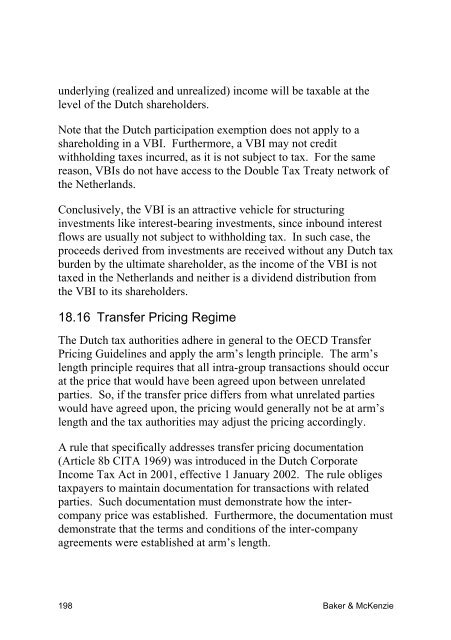Doing Business in the Netherlands 2012 - American Chamber of ...
Doing Business in the Netherlands 2012 - American Chamber of ...
Doing Business in the Netherlands 2012 - American Chamber of ...
Create successful ePaper yourself
Turn your PDF publications into a flip-book with our unique Google optimized e-Paper software.
underly<strong>in</strong>g (realized and unrealized) <strong>in</strong>come will be taxable at <strong>the</strong><br />
level <strong>of</strong> <strong>the</strong> Dutch shareholders.<br />
Note that <strong>the</strong> Dutch participation exemption does not apply to a<br />
sharehold<strong>in</strong>g <strong>in</strong> a VBI. Fur<strong>the</strong>rmore, a VBI may not credit<br />
withhold<strong>in</strong>g taxes <strong>in</strong>curred, as it is not subject to tax. For <strong>the</strong> same<br />
reason, VBIs do not have access to <strong>the</strong> Double Tax Treaty network <strong>of</strong><br />
<strong>the</strong> Ne<strong>the</strong>rlands.<br />
Conclusively, <strong>the</strong> VBI is an attractive vehicle for structur<strong>in</strong>g<br />
<strong>in</strong>vestments like <strong>in</strong>terest-bear<strong>in</strong>g <strong>in</strong>vestments, s<strong>in</strong>ce <strong>in</strong>bound <strong>in</strong>terest<br />
flows are usually not subject to withhold<strong>in</strong>g tax. In such case, <strong>the</strong><br />
proceeds derived from <strong>in</strong>vestments are received without any Dutch tax<br />
burden by <strong>the</strong> ultimate shareholder, as <strong>the</strong> <strong>in</strong>come <strong>of</strong> <strong>the</strong> VBI is not<br />
taxed <strong>in</strong> <strong>the</strong> Ne<strong>the</strong>rlands and nei<strong>the</strong>r is a dividend distribution from<br />
<strong>the</strong> VBI to its shareholders.<br />
18.16 Transfer Pric<strong>in</strong>g Regime<br />
The Dutch tax authorities adhere <strong>in</strong> general to <strong>the</strong> OECD Transfer<br />
Pric<strong>in</strong>g Guidel<strong>in</strong>es and apply <strong>the</strong> arm’s length pr<strong>in</strong>ciple. The arm’s<br />
length pr<strong>in</strong>ciple requires that all <strong>in</strong>tra-group transactions should occur<br />
at <strong>the</strong> price that would have been agreed upon between unrelated<br />
parties. So, if <strong>the</strong> transfer price differs from what unrelated parties<br />
would have agreed upon, <strong>the</strong> pric<strong>in</strong>g would generally not be at arm’s<br />
length and <strong>the</strong> tax authorities may adjust <strong>the</strong> pric<strong>in</strong>g accord<strong>in</strong>gly.<br />
A rule that specifically addresses transfer pric<strong>in</strong>g documentation<br />
(Article 8b CITA 1969) was <strong>in</strong>troduced <strong>in</strong> <strong>the</strong> Dutch Corporate<br />
Income Tax Act <strong>in</strong> 2001, effective 1 January 2002. The rule obliges<br />
taxpayers to ma<strong>in</strong>ta<strong>in</strong> documentation for transactions with related<br />
parties. Such documentation must demonstrate how <strong>the</strong> <strong>in</strong>tercompany<br />
price was established. Fur<strong>the</strong>rmore, <strong>the</strong> documentation must<br />
demonstrate that <strong>the</strong> terms and conditions <strong>of</strong> <strong>the</strong> <strong>in</strong>ter-company<br />
agreements were established at arm’s length.<br />
198 Baker & McKenzie





![912.025 AmCham News [1] - American Chamber of Commerce in ...](https://img.yumpu.com/9328612/1/190x127/912025-amcham-news-1-american-chamber-of-commerce-in-.jpg?quality=85)

